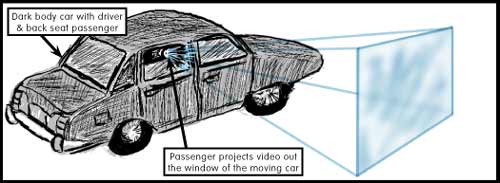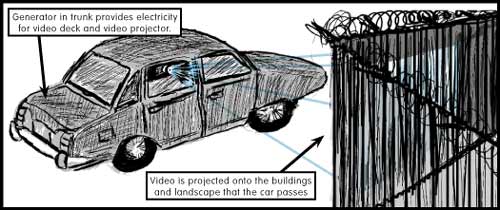|

|
 |
|
|
 |
 |
| The
artist refers to this piece as a ‘video projection
performance’. The emphasis is on the action and the
content of the video. The piece is titled ‘Drive-by’
because it is carried out in the guerrilla manner of a drive-by
shooting. The audience is mostly approached unaware and
have experienced the event before they really have time
to take it all in. The audience get to see random moments
from the video. The video is a looped clip, of short duration,
with content geared towards the environment projected onto. |
 |
| In
this example, which was part of the 3rd Annual D.U.M.B.O.
Art Under the Bridge Festival, the performance was executed
in two parts. The first consisted of a video sequence depicting
Times Square being projected repeatedly onto a derelict
block in Brooklyn. The block is surrounded by a continuous,
corrugated, galvanized, iron fence, topped with razor wire.
The car made approximately 20 laps of the block. The second
part consisted of depictions of the Brooklyn block projected
onto Times Square. The car made numerous passes through
Times Square, hitting as many surfaces as possible with
the projection. While the Brooklyn location was close to
other events in the festival and was advertised, the Times
Square part was done ‘guerrilla’ style, with no
warning and therefore no expectant audience. |
 |
| This
“Drive-by”, obviously, mimics the modus operandi
of a drive-by shooting: a slow moving, dark car with a rolled
down window creeps along near the sidewalk, ‘shooting’
video images at all that gets in its path. The superficial
images skim the surfaces and textures of the recipient walls
and objects. In the case of the block in Brooklyn, the video
image ripples as it travels along the corrugated fence.
The highly pixilated image glistens against the dull grey,
due both to the nature of the subject matter (Times Square’s
sparkling neon, tv screens etc.) and because the metal fence
reflects the projector light in all directions (the curves
of the corrugation make for a full 180 degrees of surface
to bounce off). |
 |
|
The surface glamour and glitz of Times Square has been stripped
and reapplied to the Brooklyn fence in a thin, ephemeral
veneer. What once may have impressed the onlooker now shows
itself to be just a cosmetic surface that is powerless in
any attempt to cover up the desolation of the Brooklyn block.
|
 |
| In
Times Square, where all surfaces sparkle and glow with light,
the projection of the Brooklyn block adds another layer,
another surface to an already cluttered environment. The
projection serves to remind us that the images and surfaces
that comprise Times Square are just that, image and surface.
They are only as deep as the materials they are made of
and last only as long as the advertisers pay for. The Brooklyn
images are images of reality that are momentarily usurping
the unreal. Times Square, stripped of its surface decorations,
could easily be a dark and run down neighborhood; the Brooklyn
block projection gives us a glimpse of the view through
the crack in the polished surface. |
 |
|
Of course, the artist fails to overwhelm the brightly light
billboards and monster tv screens with his images, mirroring
the inability of any individual to impact huge corporations;
but his images do make it through to the ‘dead’
spots, the holes in the fabric of consumerism and most importantly,
he is not deterred, he has tried despite the odds and it
is the doing that gives life to the piece. Should the artist
amass the financial strength to bring an enormous daylight
bright projector to the location and completely burn his
images onto the brightest billboard, we know he would; in
the meantime he has succeeded in making a small dent in
an enormous cultural icon for the few that glimpsed his
images. |
 Click
here to see more Drive-By variations Click
here to see more Drive-By variations |
|

|
  
  

|
 |

